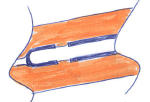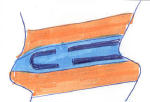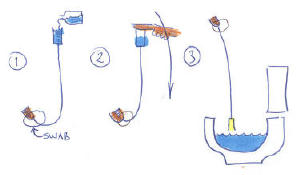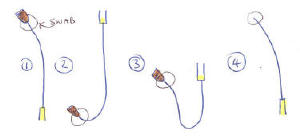 |
Links |
 |
| WEB Products |
ehecked and updated links oct 2007 |
 |
The Asta-Cath. This clever invention assists women to align the catheter correctly even
when there may be significant loss of feeling in one's hands. The link
is from the Bruce Medical Supply. Check out their generous on-line catalog - everything from wheelchairs
and hearing aids to urological supplies. |
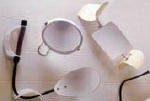 |
Clinic/Self-Cath Mirrors. from www.wisdomking.com to see around corners:
Adjustable mirror locks into any position for self-examination, catheterization,
dental hygiene or speech therapy. Acrylic 8"-square mirror is on a
free-standing 8" x 9 1/2" polyethylene base. |
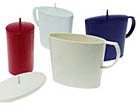 |
Carola Nilstein of Sweden has an innovative solution. To check out her site, click on the picture
left. Pipinette is a small and light potty. Due to its design a woman can pass water standing
up. For all these situations when it's more comfortable to stand. A solution
to the problem of poor or scarce toilet facilities! Special magic pad causes
urine to solidify in approximately one minute. She has guy kits too. Nilstein
cleverly uses the chemical used in diapers (vinyl alcohol casing containing
superabsorbent polyacrylate) to solidify the urine, when disposal is inconvenient.
It's even biodegradable! Check it out. |
| WEB References |
ehecked and updated links oct 2007 |
 |
Controlling Bladder Problems in Multiple Sclerosis by Nancy J Holland, RN, EdD. This e-brochure on the website of the National
Multiple Sclerosis Society is an excellent summary of the medical and physical
aspects of bladder issues with some fun graphics. |
The Joanna Briggs Institute
(Evidence Based Practice Information Sheets for Health Professionals Volume
4, Issue 1, 2000 ) |
Management of short term indwelling urethral catheters to prevent urinary
tract infections: a systematic review Based Nursing and Midwifery by Dunn
Pretty & Reid. This Australian study demonstrates that soap and water is as hygenic as
any more powerful antimicrobial or antibacterial agent/treatment, and gives
intermittent cath an edge over indwelling foley catheters. |
 |
Incontact is a leading national organisation that provides information and support
to people with bladder and bowel problems, It provides the latest information
and services available that will make a difference to your quality of life.
It is an extensive resource, including an excellent piece on self-cath. |
 |
A few hundred pdf docs are available from the home care pages of Northwestern
Memorial in Chicago. These include brief classical instructions on self
catheterization. Click Male or Female to view. It's pretty plain they're not written by users, but they are
worth reading. |
| The Kit |
 |
 |
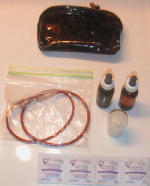 |
Water Catheter - Pocket Kit One.
The kit is made up so: the Water Catheter in a ziplock sandwich bag, a
bottle of water, a bottle of ostomy appliance cleaner (phosphoric acid
solution), a container of lotion, 4 antiseptic towellettes, and a plastic
pouch as small as still fits into your pocket. I carry it in my back pocket.
This kit is a real boon to your confidence and an alternative to running
to the loo every 45 minutes. It is more than sufficiently antiseptic and
very cheap. |
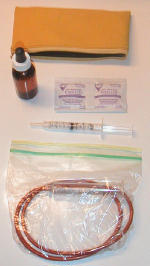 |
Water Catheter - Pocket Kit Two.
This is the same as above with some small change to reduce the bulk.
It is for when the larger pocket pouch is too large and the minimum equipment
is to be carried as for a trip out for dinner or the theatre. Where one
or two uses are all that is required before a return home and you want
a slimmer more discreet package for your pocket.
The single bottle is water only, and the more slender syringe is used to
insert some lotion to ease the passage of the catheter. And a few disinfectant
wipes.
When the parasthesia is not being bothersome, and the urethra not so sensitive,
I simplify it a bit more. I replace the syringe with a little bottle of
lotion and just dip the end of the catheter into it. I also don't bother
with the water bottle then. The lotion is enough to lubricate the entry.
And the tubing of course is full with urine when complete, so by raising
the tubing vertical the few inches of water pressure ensures a gentle withdrawal.
Just be careful with the last couple of inches and timing the lowering
of the tubing to the toilet.
This fits most readily in your pocket and is easy to maintain. |
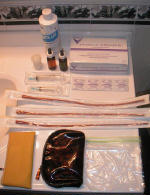 |
The elements of the kit to purchase at the medical supply store, drug store, or internet store. The brands may change from region to region but here are some of the details.
From top to bottom. 1. Ostomy appliance cleaning solution: Urolox - phosphoric acid based. I
first used a bleach. But after a few too many little splashs of bleach
spoiling sweaters and pants, I found a safer but effective sterilizing
cleaner. 2. Package of Antiseptic towellettes. 3. A 35mm film container. 4. 2 eyedropper glass bottles. These worked out as the easiest way to dispense
small amounts without leaking. Druggist will sell you empty bottles. 5. A small (3 mm) syringe for kit two for dispensing lotion. 6. A medium syringe (10 mm) to make the catheter assembly. 7. A range of catheters (see below). 8. a couple of pocket zipper bags - must be washable plastic - no lining.
9. Some zip-lock plastic sandwich size bags. This stuff is cheap and cleans
easy. The catheters last a couple of months and are only a buck a piece. |
 |
Another sort of syringe that adapts well to the kit purpose. This one is intended to dispense
medicine to children and has a snap cap. Very suitable to fit to the catheters.
And suitable to dispense lotion since it has a snap cap. |
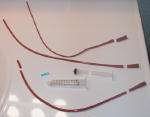 |
The Water Catheter Elements. The syringe is shown in parts. Discard all but the cylinder which is used
as a well for the water. We'll refer to this cylinder as the vial.
Observe the three catheters and the place of their cutting. Detail is clear
on larger picture. Click left.
The largest one (Size 16 FR. 5.3 mm) is cut at both ends simply to make
an extension tube between the cylinder and the catheter.
The other two catheters are cut only at the funnel end so as to push-fit
into the larger one above. |
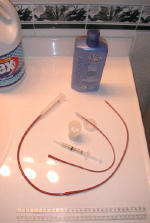 |
The Water Catheter Assembly. The outer loop shows the principle assembly of syringe cylinder (vial), tubing extension and appropriate catheter. Either of 2 sizes are used.
There are occasions when paresthesia makes insertion of the medium size
catheter that normally fits the urethra best, most uncomfortable. (Size
14 FR. 4.7 mm in my case). So a smaller diameter catheter is part of the
kit and is just press-fitted from time to time to the upper assembly. (Size
10 FR. 3.3 mm). This smaller tube is shown inside the first loop in the
picture. You will notice in the larger picture that the smaller catheter
tip has been dipped into the lotion to ease entry. Little is required.
In the centre of the picture there is a small syringe for dispensing hand
lotion and also a plastic bottle (film container) for the same purpose.
Depends on which kit. |
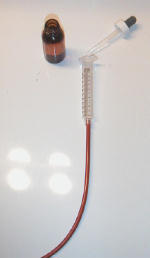 |
Basic Principle. This photo shows the use of the eye-dropper dispenser bottles, and illustrates
the basic concept of the Water Catheter System. By filling the tubing with
water and having a vertical elevation of the apparatus, there is a small
head of pressure - simply the number of inches of height. This slight pressure
of water displaces the immediate area near the catheter inlet holes and
prevents actual contact with the tender skin. Then one can insert and remove
the tubing without it feeling like a carpenter's chisel scraping along
the way. When paresthesia is not a huge bother, you may find the lotion
eases the passage sufficiently.
One has control of outflow by placing the thumb over the vial top. At the
beginning one can control the water pressure and bypass with thumb-over
control. On removal, one contains the 3 ml urine within the tubing and
from spilling by thumb-over control. |
| Safety Risk for the Absent Minded. Please consider whether it is appropriate in your case to have both bottles
the same kind as I do. One bottle is filled with a strong blue-coloured
acid and the other with clear water. It would be ugly to confuse them.
As an alternate, you can skip the Urolox, just rinse with water and wipe
the outside with a towellette. Then from time to time, have a more thorough
cleaning routine of everything. |
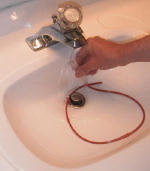 |
Clean up is easy. First wash the outside with soap at the same time you wash your
hands. Then run some water through and over the system. |
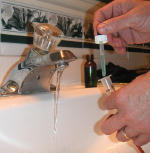 |
Then put in a bit of Ostomy Appliance Cleaner. If you find you can tolerate
the easier regime of cleanliness, you can skip this step. |
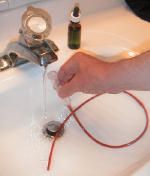 |
And flush with more water. |
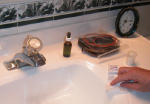 |
Use an Antiseptic towellette to wipe down the area you have used for prep and cleanup at the sink.
You may also use the towellete to wipe the outside of the tubing. This
is a proper courtesy when you are visiting. It is not really required in
your normal place, where soap and water are quite sufficient. |
 |
From time to time, take everything apart and clean it in soap and water, then soak it a while in a bleach solution. Be sure to include the plastic
pocket pouches that contain the kit. Don't keep the zip-lock bags, just
replace with new ones. |
 |
1 Litre Bottle. Take a plastic container of 1 litre volume. Then calibrate it by filling
with other containers that are marked as to volume because it's probably
not symetrical - note the non-linear numbers on the left illustration.
This can be imprecise, say within 10 percent, because it's only a guide.
This simple thing let's you know without the high tech the doctors use to establish what
your bladder capacity is, to what degree you are over extending that, and
what precisely is the residual amount left. Just pee in the bottle, measure
and dump. Then using a catheter, drain the remainder into the bottle, record
and dump. The sum of the two drainings is the capacity of your bladder.
Do this from time to time to get an average and to see if there are changes
or cycles in this matter.
Transfer Bottle. You can also use the bottle to transfer urine to the toilet when at the
start this matters are a bit tricky to coordinate.
Clean up the bottle with a good rinsing and then a bit of bleach or Ostomy Appliance
Cleaner and another rinse before putting away. |
| Update |
 |
 |
| Oct 2007 |
For the last couple of years, I've simplified the kit a bit. The parathesia
has diminished enough that simple lubrication is sufficient. I still use
kit 2 above as a pocket kit and for travel, but below is described and
shown my present home kit. |
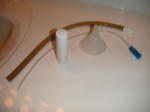 |
Notice the standard catheter has a flexible female funnel fitting. This
fits it to the male fitting used in the catheter business. Note the white
fitting at the end of the piece of 1/4 inch surgical tubing. All available
at the medical supply houses. The little bottle contains regular hand lotion
which is refilled from whatever bottle you might have. The bottle provides
a separate place to dip the catheter end into for lubrication. Lastly notice
the little 2 inch funnel. |
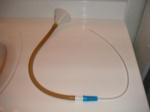 |
Here the pieces are put together in the form for regular use. The funnel
gives some weight to the apparatus towards the toilet bowl. It also facilitates
cleaning later. The larger diameter tubing of the bit of surgical tubing
is quite a bit less resistance than joining two catheter tubes as above,
and makes for less total time. |
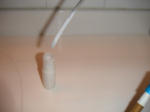 |
Here is the business end of the catheter after dipping in the lotion. The
little bottle is just the right thing for this purpose. I use such a little
bottle now in the pocket kit above as well rather than a little syringe. |
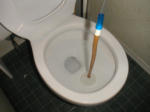 |
Here is an indelicate shot. Sorry. But you can readily see that the urine
is delivered in a convenient non-splash way where it needs to go. When
done, one elevates the funnel upwards in front of the chest. That creates
a small water pressure displacement of the urethra wall near the catheter
holes, and greatly eases withdrawal. Just be sure to stop at the last few
inches and put the funnel-end lower than the catheter-tip-end so the amount
in the tubing is not spilt but dispatched cleanly. |
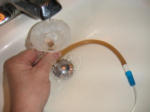 |
This is how easy it is to clean up. Just rinse for a minute thusly. |
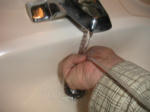 |
And then soap your hands and before rinsing your hands wash to outer part
of the kit and rinse so.
I don't even contain it any longer in a bag, but toss it into the appointed
drawer. |
| Update August 2010 |
A Catheter Improvement Method |
Inventor's Own Descriptions |
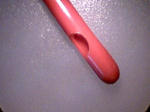 |
Charles T. Tart, Palo Alto, California, has found a nice trick for dulling
the knife edges on plastic catheters. He sends a couple of photos and a
description to share. For a fuller discription click link above. On the left is a shot of the sharp edges new catheter. |
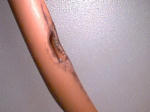 |
This shot shows the catheter having been modified by the heat of a soldering
iron to soften the contours of the hole. "It feels enormously better
than the factory edges." he says. I coil my latex catheter up in a
wide-mouthed bottle of rubbing alcohol in between uses and so one catheter
can last a year or more. It's important to dry it off and drain it before
use, of course, you don't want alcohol in the urethra drying out the flesh.. |
| Practical Matters |
Some practical details follow for which some tasteful sketches replace
indelicate pictures. |
 |
























